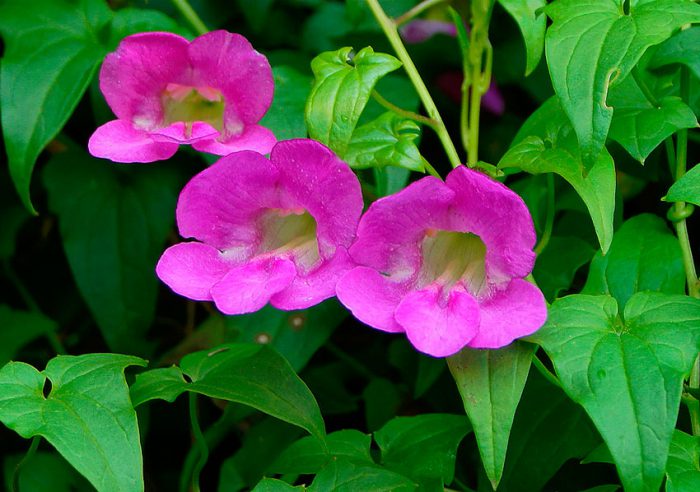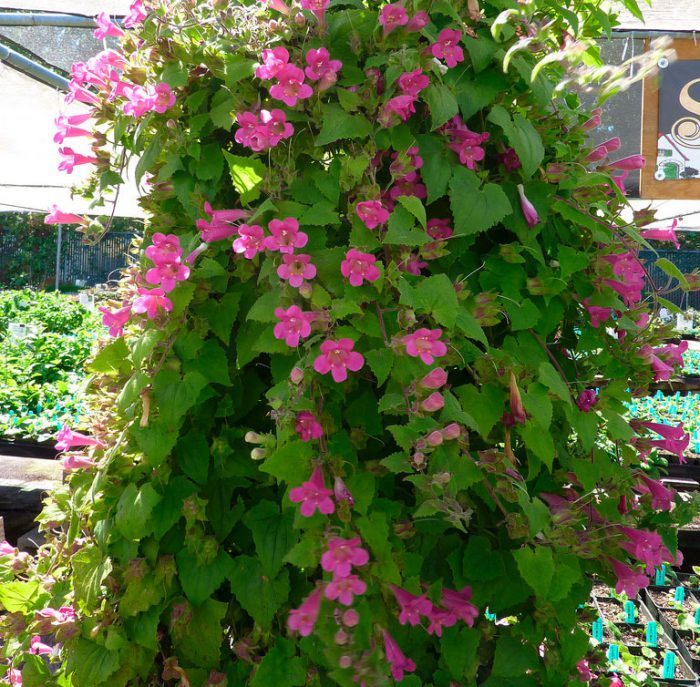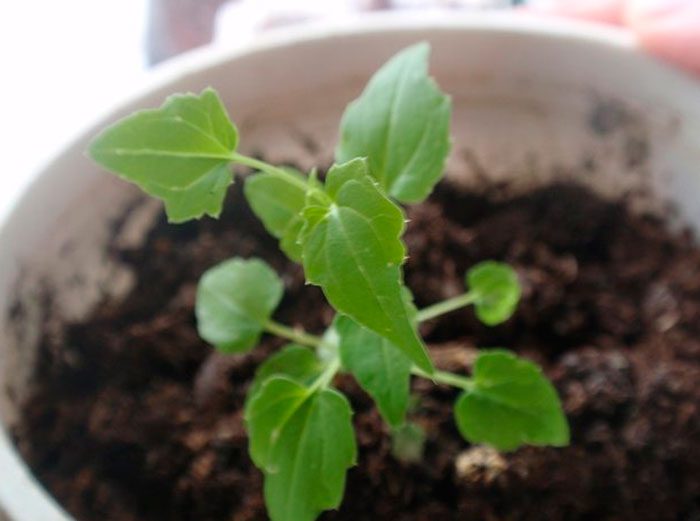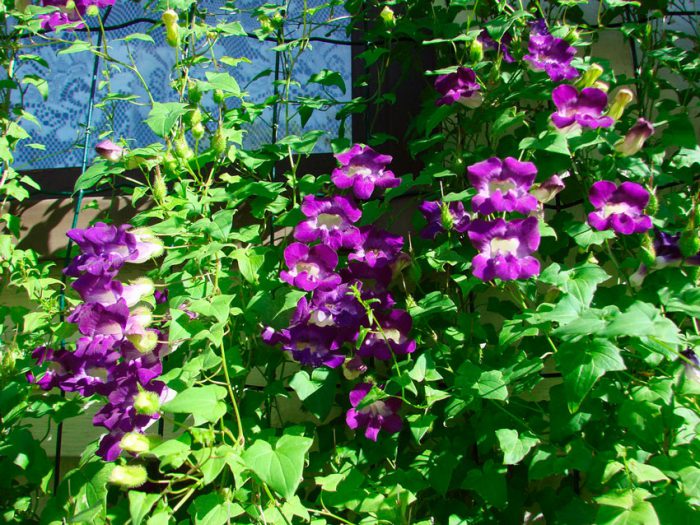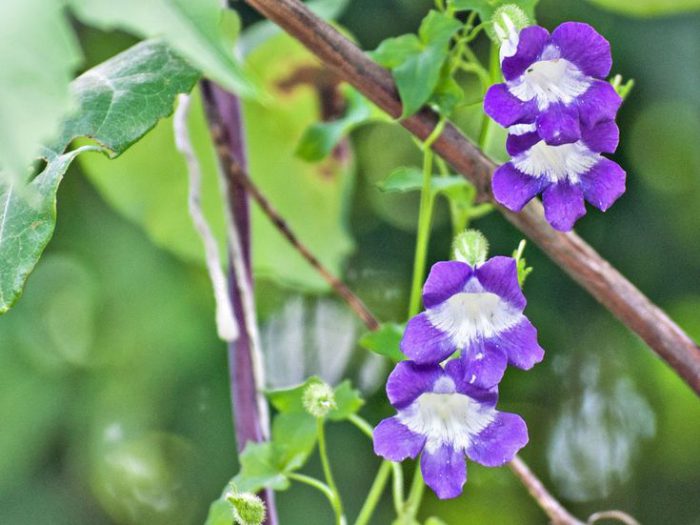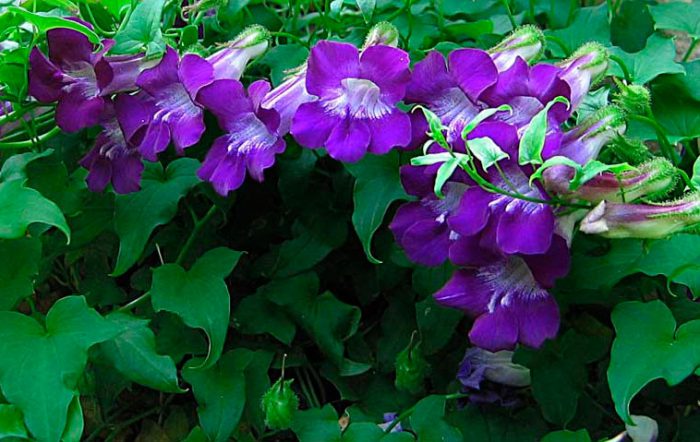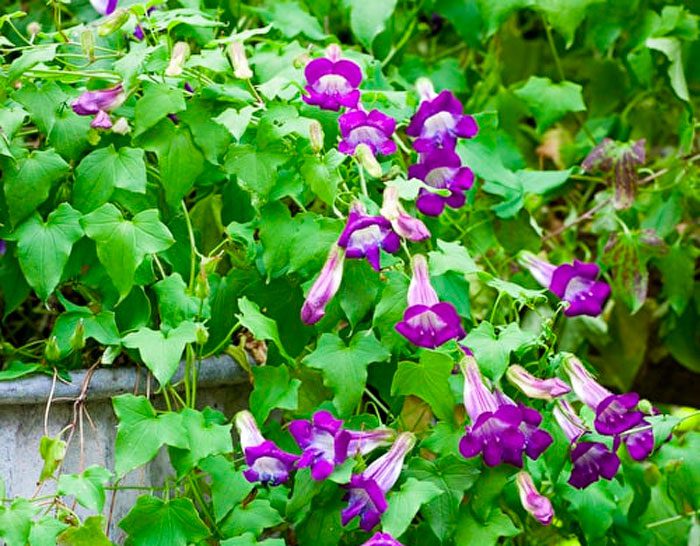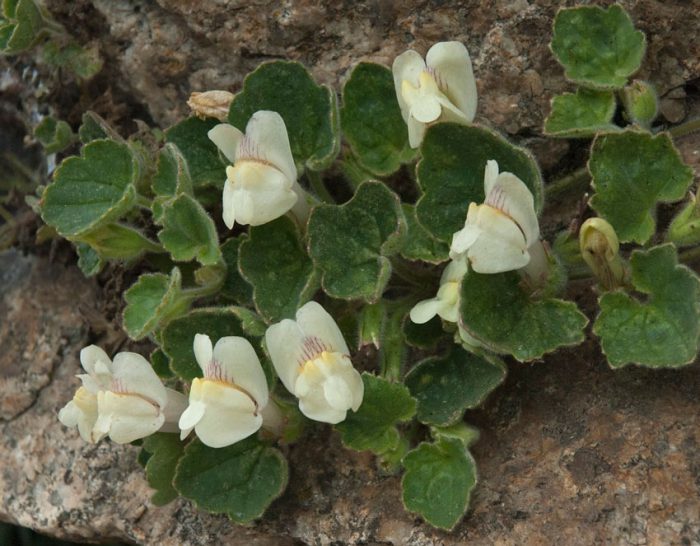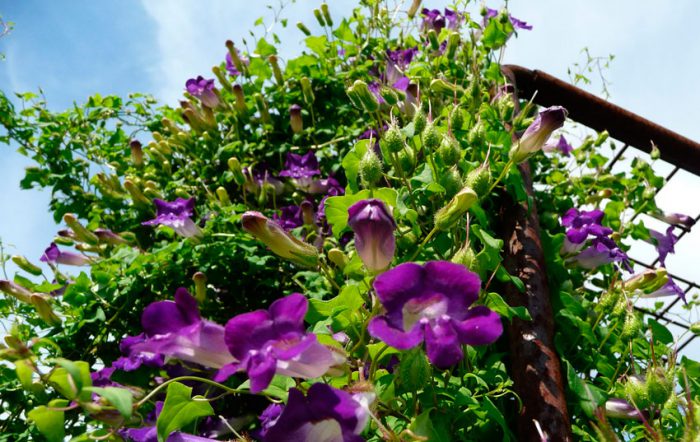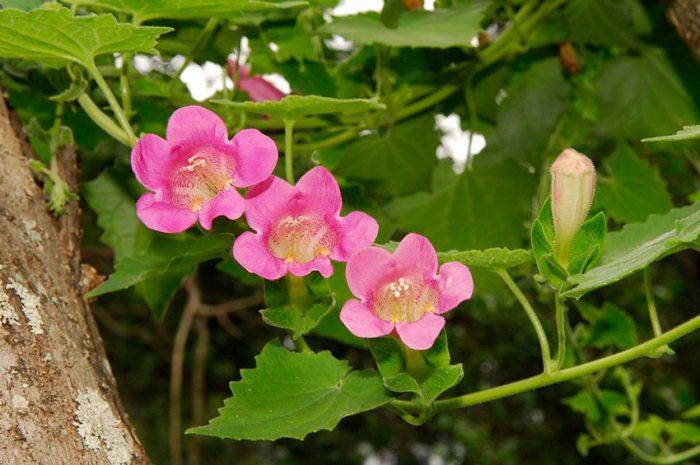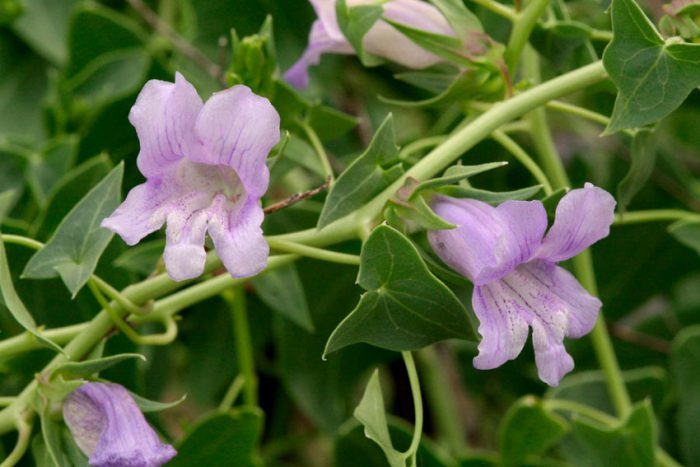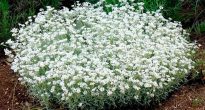The flowering plant, Asarina, or Maurandia, is a climbing perennial belonging to the plantain family. However, there are also sources that say that this plant is a representative of the norichnik family. This genus unites about 15 species. Azarina is native to California, Mexico and the central United States. But since the 17th century, the popularity of Maurandia began to grow steadily, and this has led to the fact that it is now growing in almost every corner of the planet Earth. In middle latitudes, this perennial is grown as an annual plant. It is used, as a rule, for vertical gardening.
Content
- 1 Features of asarin
- 2 Growing asarina climbing from seeds
- 3 Planting asarina climbing in open ground
- 4 Asarin care
- 5 Types and varieties of asarinas with photos and names
- 5.1 Climbing Azarina (Asarina scandens = Asarina semperflorens = Usteria scandens)
- 5.2 Azarina prostrate (Asarina procumbens = Antirrhinum asarina)
- 5.3 Azarina antirrhiniflora (Asarina antirrhiniflora)
- 5.4 Azarina Barclaiana
- 5.5 Azarina blushing (Asarina erubescens)
- 5.6 Azarina Purpusa (Asarina purpusii)
- 5.7 Azarina wislizenii (Asarina wislizenii)
Features of asarin
The climbing asarin has strongly branching shoots, the length of which is 3–7 meters. Shoots cling to the support thanks to the twisting thin petioles. Small bright green velvety or bare leaf plates, can be serrated or whole-edged. Their shape is round-triangular, the base is heart-shaped, and the apex is pointed. Large tubular axillary flowers are single, they are located along the entire shoot, up to its apex. The most common color of flowers is pink, purple and purple, less often they can be colored yellow or white. Plants with bicolor flowers are very rare. Asarina blooms in the last days of June, and the end of flowering falls on September. The fruit is a capsule, which includes 2 cells, inside them there are small pointed seeds.
Growing asarina climbing from seeds
Sowing
Asarina climbing, as a rule, is grown through seedlings. In order for flowering to begin in June, the sowing of seeds must be done in winter about 2.5–3 months before transplanting the seedlings into open soil. For sowing seeds, an earth mixture is used, consisting of sand, humus, peat and leafy soil (1: 1: 1: 1). Such a soil mixture needs to be disinfected, for this it needs to be disinfected for 10 minutes. placed in the microwave, which is turned on at full power.Then the soil is spilled with a strong solution of potassium manganese, which must be very hot, after which it must be allowed to rest for 24 hours.
The container is filled with a loose damp earth mixture. On its surface, it is necessary to distribute seeds, which are slightly pressed into the substrate and sprinkled with a half centimeter layer of calcined sand. Crops must be watered from a spray bottle. The container should be covered with glass or film and removed to a cool place (from 15 to 20 degrees), while do not forget to ventilate the crops every day, removing the shelter for 2-3 hours. If after 1 month the seedlings did not appear, the crops are transferred to the cold for 30 days, and then again placed in heat.
Growing seedlings
When the first seedlings appear, the shelter will need to be removed, while the container should be rearranged to a well-lit place. A pick is made after the plants have 2 or 3 true leaf plates, for this, individual peat pots are used.
The transplanted plants need to be watered systematically and provided with good lighting. When 1.5 weeks have passed from the moment of picking, the plants will need to be fed with a solution of complex mineral fertilizer, for example, Ideal. After another half month, the plants are fed with Agricola's solution. Further feeding will directly depend on the growth and development of the plants. If the growth of azarina is rather slow, then fertilization with phosphorus and potassium should be done, and if the plants have very small or faded leaves, then this means that they need nitrogen.
Before planting asarin in open soil, it should be hardened for two weeks. Every day, the seedlings should be transferred outside, while its time in the fresh air should be gradually increased until it fully adapts to the new conditions.
Planting asarina climbing in open ground
What time to plant
Asarin seedlings are planted in open soil only after the threat of return frosts has passed, and this time, as a rule, falls on the second half of May. Such a plant is very fond of warmth, therefore, the site chosen for planting should be sunny and have good protection from cold winds and drafts. It should be borne in mind that at noon, when the sun is most active, such a flower needs shading. It is best if the soil is breathable, loose and well-drained. Loamy neutral soil is ideal for growing asarin.
How to land correctly
In order for the bushes to grow and develop well, they need an area of at least 0.6 m.In this regard, a distance of 0.6 m should be observed between the holes.At the time of planting, you also need to do the installation of a support, the best for this is a grid of metal with medium cells or vertically stretched metal wire. Fortified and established plants must be tied to a support.
Asarin care
Azarina loves moisture very much, therefore, on hot dry days in summer, she needs to be provided with watering 2 times a day (in the evening and morning). During watering, it is also recommended to moisten the foliage of the plant from a spray bottle using boiled lukewarm water. The soil near the bushes must be systematically loosened, while pulling out all the weeds. To significantly reduce the number of watering and weeding, the surface of the site should be covered with a layer of peat.
The plant needs systematic feeding. In order for the plant to bloom for a very long time after the first flowers appear, it will be necessary to start feeding with a complex mineral fertilizer, which mainly contains phosphorus and potassium. Such dressings are made once every 1–1.5 weeks. You can also use a solution of chicken manure for feeding. To bloom for a long time, do not forget to promptly cut off the flowers that have begun to fade.
Diseases and pests
Asarin seedlings can become infected with root collar rot, or black leg.As a rule, plants become infected from the moment the shoots appear and until the development of 2 or 3 true leaf plates. In an infected plant, the root collar becomes dark, a black constriction appears on it. After a few days, the shoot in this place becomes soft and it breaks, as a result of which the seedling lodges. After it turns out that the plants are infected, you need to immediately transplant healthy seedlings into a fresh, well-disinfected soil mixture. They are removed to a warm place that is protected from direct sunlight. Irrigation water should be mixed with a fungicide (Baktofit, Maxim or Fitosporin), do not forget to read the instructions first. Infected plants must be destroyed.
The greatest danger to asarin in the garden is aphid. This insect sucks plant sap from foliage, flowers, shoots, buds and buds. As a result, the entire aerial part of the plant becomes twisted and deformed. Also, a sooty fungus may appear on the plant due to the sugary secretions of aphids. To destroy such a pest, insecticides are used, for example: Karbofos, or Fufanon, Akarin, Bankol or Aktellik. To completely get rid of aphids, plants will need to be sprayed with insecticide again 1–1.5 weeks after the first treatment.
Types and varieties of asarinas with photos and names
Climbing Azarina (Asarina scandens = Asarina semperflorens = Usteria scandens)
This type is most often cultivated by gardeners. Its detailed description can be found at the beginning of the article. Most popular varieties:
- Bridges White... The color of the flowers is white.
- Joan Lorraine... The flowers are dark purple.
- Mystic rose... The color of the flowers is deep pink.
- Red Dragon... The flowers are colored scarlet or bloody red.
- Sky Blue... Flowers of medium size are colored blue.
Azarina prostrate (Asarina procumbens = Antirrhinum asarina)
The homeland of this species is the northeastern part of Spain and the southwest of France. The most common variety of this type is the Sierra Nevada. In such a plant, the horizontally spread stems are fleecy. The length of the pale green triangular leaf plates with a serrated edge is about 6 centimeters, they have long petioles, on the surface of which there is pubescence. The length of the tubular flowers is about 40 mm, their color is soft yellow. This flower is not afraid of short frosts no more than minus 15 degrees.
Azarina antirrhiniflora (Asarina antirrhiniflora)
The length of this type of stem can vary from 150 to 250 centimeters. The shape of the small leaf plates is cordate. The flowers are tubular elongated bells, reaching 30 mm in length, their color can be sky blue, pale purple, deep red or white. There are spots on the pharynx surface. The plant blooms at the beginning of the summer period, while flowering ends with frost.
Azarina Barclaiana
The homeland of such a branchy liana is Mexico. Its length is about 350 cm. Heart-shaped leaf plates have a pointed apex. The length of the bell-shaped flowers is 70 mm. Their color can be pink, crimson or lilac. The pharynx is always colored in lighter shades.
Azarina blushing (Asarina erubescens)
The length of the stems of such a creeping flower reaches 350 cm, while along the support it can rise to a height of no more than 120 cm. The length of the velvety heart-shaped leaf plates is about 8 centimeters. The flowers are about 70 mm long, they are tubular and light pink in color. There are spots on the surface of the white throat.
Azarina Purpusa (Asarina purpusii)
Such a flower has many spreading thin shoots, the length of which is 0.3–0.4 m. The heart-shaped leaf plates reach 50 mm in length and have a sharp top. The shape of the flowers is funnel-shaped, the length of their tubes is 50 mm. Their color is carmine or pale purple.
Azarina wislizenii (Asarina wislizenii)
The color of large flowers is pale purple or blue.The Red Dragon variety has deep red flowers.

